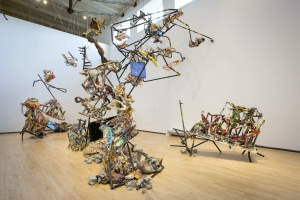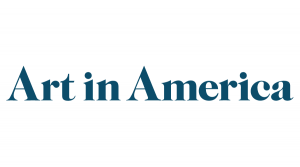SYMBOL OF SUBSTANCE: “CERAMICS IN THE EXPANDED FIELD” AT MASS MOCA
BY JANET KOPLOS
MARCH 24, 2022

Mass MoCA curator Susan Cross drew the title of this exhibition, “Ceramics in the Expanded Field,” from Rosalind Krauss’s influential essay about sculpture—published in an earlier form in this magazine in 1979—that was initially inspired by John Mason’s ceramic installations. In returning to ceramics, Cross both highlights the medium and suggests that it has exceeded its own limits as a category, as Krauss wrote of sculpture. The show features eight artists working in clay who draw on issues of history, identity, and tradition, particularly the question of ceramic utility.
The most impressive work in the show is Linda Sormin’s gargantuan agglomeration of tangled clay tubes, numerous video screens of varying size, a section of a spiral staircase, a dragon head used in Chinese festival dances, and detritus, arcing through the air within and around a zigzag metal framework. Though static, the form suggests exuberant motion, like a whiplashing fire hose. The creation might seem at first apocalyptic, a triumph of disorder; to the contrary, its title, Stream (2020–21), highlights the video images of flowing water and abstract patterns as well as the sculpture’s overall fluid aerial configuration, recalling the acrobatics of flying dragons in Chinese myth and art.
No other work here packs quite that power, although most have their own strengths. Anina Major also combines clay, video, and structure in a work titled All Us Come Across Water (2021), referencing, in part, the African diaspora. The title appears in neon at one end of a wooden dock spanning an expanse of ceramic shards evoking shell middens; at the other end are three large pots, two of them assembled like baskets. On a video monitor atop a smaller adjacent dock, hands with long blue nails demonstrate the process of plaiting clay strips, gingerly manipulating the pliant, vulnerable material into the form of a container. Except for the title, nothing is verbalized about passage or labor, but a viewer can sense the ache of longing in the distance between this intimate act of crafting, like braiding hair, and the dislocated appearance of the docks on a shattered ground—a tension heightened by the literal separation of the video from the larger dock.

Rose B. Simpson presents a mural-size photograph of her customized lowrider, painted in the black-on-black patterning made famous by potter Maria Martinez, who was, like Simpson, a Tewa artist from New Mexico. The work is beautiful, yet an act of homage rather than invention; more compelling is her Countdown III (2021), comprising three nearly eight-foot-tall ceramic figures leaning their foreheads on a post, balancing each other and seemingly sharing some condition or emotion. Huge, powerful, ornamented with paint and necklaces, they are also painfully vulnerable, lacking both arms and feet. Armando Guadalupe Cortés presents a set of 2017 videos in which he is constrained in a different way. He stands with ceramic pots tied to his long braids, swinging his head until they break, or holding up the vessels until his arms give out and the pots collide. It’s a mesmerizing activity—a dance of pain and endurance—but is his point to honor traditional form and utility, or to destroy it? The exhibition leaflet claims that the videos present a reflection on gendered labor, but this is extravisual.
The ceramic works of Nicole Cherubini, Jessica Jackson Hutchins, and Francesca DiMattio have had considerable exposure in New York galleries. In the context of this exhibition, however, all seem to strain. Cherubini adds photographs and potted plants to her vessels, and Hutchins uses her disassembled-furniture-plus-clay-sculptures as sets for music and performance videos featuring damaged objects and crawling bodies. DiMattio creates three monstrous but jokey figures—embedded with a teddy bear and Legos—in addition to an eccentric chandelier and a mural as insouciant as, but less witty than, Ann Agee’s 1992 Lake Michigan Bathroom mural. While DiMattio energetically combines decorative tile traditions from many cultures, Agee’s droll imagery adopts the well-known blue-and-white style of ceramics to render industrially produced sanitary applicances, including a urinal.
Kahlil Robert Irving’s landscapes are the least satisfying contribution. In front of a wall-size digital print of the sky, he presents tiled “grounds” on low or table-height platforms on which ceramic objects, decals of cigarette wrappers, images of newspaper clippings, and other printed materials are set into clay. The titles, some elaborately worked out in color and typography, may suggest a search for place or identity, but the incorporated materials are so varied that this seems to be a case of throwing in everything in the hope that something might stick.
Clay ultimately serves here as a token, symbolizing heritage (Simpson, Major, and Cortés) or environment (Hutchins and Irving), or challenging a formal tradition through exaggeration (DiMattio and Cherubini). The works’ placement in a medium-centric exhibition foregrounds the question of how clay retains its meanings in this expanded field.
______________
Contact us to inquire about available works by Linda Sormin.
